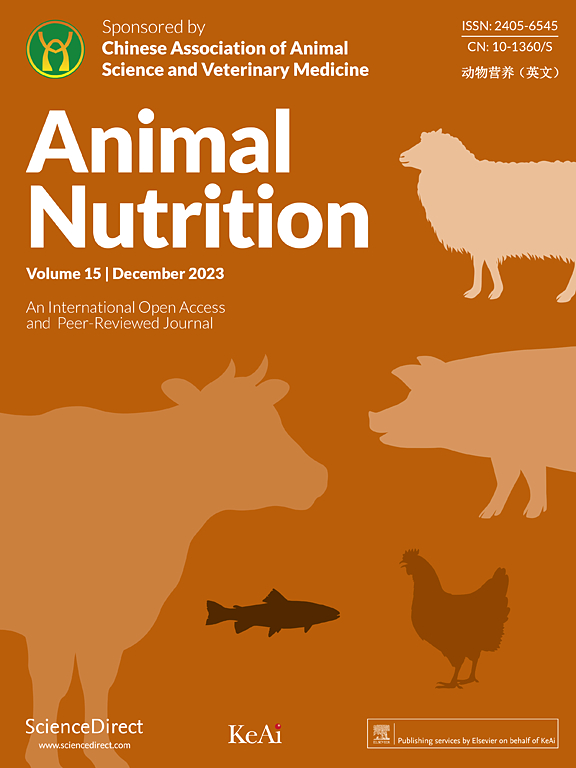Rosemary leaf powder improves egg quality, antioxidant status, gut barrier function, and cecal microbiota and metabolites of late-phase laying hens
IF 6.1
1区 农林科学
Q1 AGRICULTURE, DAIRY & ANIMAL SCIENCE
引用次数: 0
Abstract
This study sought to determine the effects of rosemary leaf powder (RP) on laying performance, egg quality, serum indices, gut barrier function, and cecal microbiota and metabolites of late-phase laying hens. A total of 84 “Jing Tint 6” laying hens at 65-week old were randomly divided into 2 groups and fed either a basal diet (CON) or a basal diet supplemented with 0.3% RP. Our study revealed that RP improved the Haugh unit and decreased yolk n-6/n-3 polyunsaturated fatty acid (PUFA) ratio of laying hens, increased serum superoxide dismutase (SOD), jejunal activities of SOD and catalase (CAT), and jejunal zonula occludens-1 () expression, as well as decreased serum tumor necrosis factor-α (TNF-α) level and jejunal mRNA expression. RP markedly enhanced ( < 0.05) cecal abundances of Rikenellaceae, , and , tended to promote ( = 0.076) butyrate concentration, and reduced ( < 0.05) cecal abundances of Erysipelatoclostridiaceae, Sutterellaceae, Fusobacteriaceae, Campylobacteraceae, , , and , which were closely linked with Haugh unit, yolk n-6/n-3 PUFA ratio, serum SOD and TNF-α. In addition, RP altered the metabolic functions of cecal microbiota and enhanced the abundances of butyrate-synthesizing enzymes, including lysine 2,3-aminomutase, β-lysine 5,6-aminomutase, and 3-oxoacid CoA-transferase. Together, 0.3% RP has the potential to enhance egg quality by partially modulating serum antioxidant status, jejunal barrier function, and cecal microbiota structure and metabolites, indicating that RP could be considered a promising feed additive to promote the production performance of late-phase laying hens.迷迭香叶粉可改善蛋鸡后期的鸡蛋质量、抗氧化状态、肠道屏障功能以及盲肠微生物群和代谢物
本研究旨在确定迷迭香叶粉(RP)对后期蛋鸡的产蛋性能、鸡蛋质量、血清指数、肠道屏障功能以及盲肠微生物群和代谢物的影响。将 84 只 65 周龄的 "京腾 6 号 "蛋鸡随机分为两组,分别饲喂基础日粮(CON)或添加 0.3% RP 的基础日粮。我们的研究发现,RP 可改善蛋鸡的哈氏单位,降低蛋黄中 n-6/n-3 多不饱和脂肪酸(PUFA)的比例,提高血清超氧化物歧化酶(SOD)、空肠 SOD 和过氧化氢酶(CAT)的活性以及空肠 zonula occludens-1 的表达,降低血清肿瘤坏死因子-α(TNF-α)的水平和空肠 mRNA 的表达。RP显著提高(< 0.05)盲肠中Rikenellaceae、Ⅳ和Ⅴ的丰度,并有促进(=0.076)丁酸盐浓度的趋势,同时降低(< 0.05)盲肠中Erysipelatoclostridiaceae、Sutterellaceae、Fusobacteriaceae、Campylobacteraceae、Ⅳ和Ⅴ的丰度,这与Haugh单位、卵黄n-6/n-3 PUFA比率、血清SOD和TNF-α密切相关。此外,RP还改变了盲肠微生物群的代谢功能,提高了丁酸合成酶的丰度,包括赖氨酸2,3-氨基变构酶、β-赖氨酸5,6-氨基变构酶和3-氧代酸CoA-转移酶。总之,0.3% 的 RP 有可能通过部分调节血清抗氧化剂状态、空肠屏障功能以及盲肠微生物群结构和代谢物来提高鸡蛋质量,这表明 RP 可被视为一种有前途的饲料添加剂,可促进后期蛋鸡的生产性能。
本文章由计算机程序翻译,如有差异,请以英文原文为准。
求助全文
约1分钟内获得全文
求助全文
来源期刊

Animal Nutrition
Agricultural and Biological Sciences-Animal Science and Zoology
CiteScore
7.40
自引率
3.20%
发文量
172
审稿时长
12 weeks
期刊介绍:
Animal Nutrition encompasses the full gamut of animal nutritional sciences and reviews including, but not limited to, fundamental aspects of animal nutrition such as nutritional requirements, metabolic studies, body composition, energetics, immunology, neuroscience, microbiology, genetics and molecular and cell biology related to nutrition, and more applied aspects of animal nutrition, such as raw material evaluation, feed additives, nutritive value of novel ingredients and feed safety.
 求助内容:
求助内容: 应助结果提醒方式:
应助结果提醒方式:


